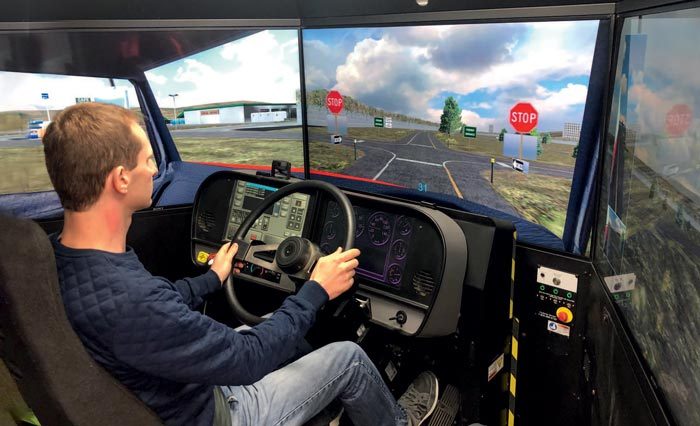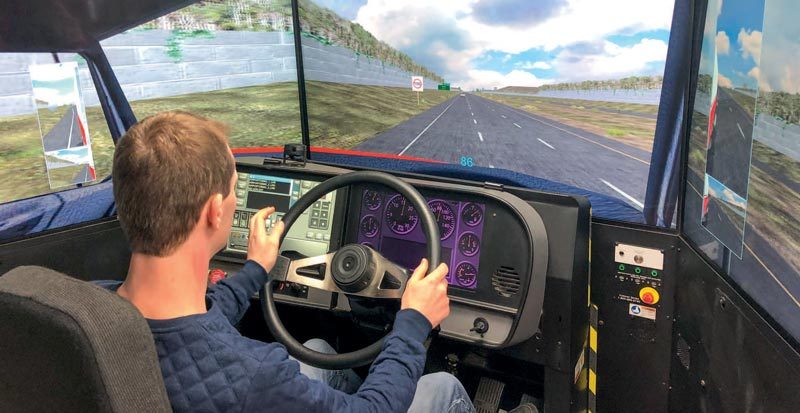After nearly a decade of writing about and working with trucks, the time has finally come for me to actually be able to legally drive them on the road…

Photo: Assistant editor Gavin takes on the AutoSense simulator.
I don‘t know how it‘s happened – or, rather, not happened – but I‘ve somehow never got around to attaining a heavy vehicle licence. Sure, I‘ve driven trucks plenty: big, small, laden, empty, rigids, B-trains, tippers, mixers, bare chassis … but almost always the driving has been on closed roads or private land, and every now and then on challenging off-road tracks (where appropriate for the vehicle) or race tracks and skidpans (yes, I know, highly relevant to the industry). Don‘t get me wrong, I‘ve had the best of intentions and many industry players have offered their services over the years, but somehow things have just never fallen into place. Until now – finally! Thanks to the support of the upstanding folks at TR Driver Training (formerly TR Master Drive Services), I‘ll be making my way up the licence class system over the coming months.
Because I‘m over 25 and publishing needs a level of expediency, I‘ll go through the Accelerated Class 2 to 5 Learner Courses. This will allow me to skip the three-month period between obtaining one full licence class and moving on to the next. Once I‘ve obtained my class 2, 4 and 5 licences I‘ll then go for a few relevant endorsements. There is a second part to this journey and that‘s to show those interested in getting their licences off their own bat how they could go about doing it. For many aspiring truckies, finding a driving job requires them to already have a licence. For some, this involves simply getting their class 2 in order to break into the industry – with many employers offering advancement opportunities down the line. Others may already have a class 2 or 3 licence and aim to better their driving skills or further their career prospects.

At this stage I‘ve received my class 2 learners – a simple process of studying the NZTA‘s Road Code for Heavy Vehicle Drivers and sitting a multiple choice theory test at your local testing agent – and by the time you read this I‘ll have already attended the TR Driver Training logbook/ class 2 theory lessons and done the class 2 practical test (hopefully I pass, or next month‘s instalment might be a bit awkward…) However, my licence journey actually started a few months ago in an AutoSense simulator. I met up with Ronald Deane, simulator programme manager at AutoSense, when he brought the simulator to Mt Maunganui, to get a taste for what it is the simulator does and to see how I might do behind the wheel before having even picked up the road code. The AutoSense simulator (built by American defence force contractor L3Harris) is used for competency evaluation, and reports on how good a driver is at driving and places them into a risk rating category for their employers to decide on further coaching and training. “We put drivers through a set of scenarios, based on their specific operations, and assess every aspect of their driving including spatial awareness, speed management, following distance, and others,” Ron explains. The scenarios are designed to be as close to the local environment as possible but there‘s potential to design just about anything into the system.
Drivers can drive on mountain passes, dirt roads, or construction sites for example. Anything from the smallest ute or van to buses and quad-trailer road trains can be simulated, with manual or automatic transmissions, but the system goes further … the simulator module moves to mimic the g-forces acting on the vehicle. So the driver of a tanker can feel the liquid moving behind him as he accelerates and brakes, for example. Or a blowout, side winds, or descending an icy hill can be simulated. The system can even simulate intoxication or distracted driving – diverting the driver‘s attention just before throwing out a hazard. There are sensors in every part of the simulator.
It‘ll measure how harshly the accelerator and brake are pressed, whether the indicators or hazards are used when needed, how much steering force is applied, or how fuel efficiently the truck is being driven, to name a few parameters. “Everything in the simulation is strategically placed to test how the driver thinks and reacts,” Ron says. And the drivers? They either love it or hate it, he says. “Some think it‘s nothing for them, that they‘re already good drivers. A lot of them get competitive and can‘t wait to see how they‘ve done.” So how did I do? Well, as Ron kindly let me interrupt his day of evaluation at a local haulier, I unfortunately couldn‘t go through the full simulation and get a report on my entirely novice abilities. However, if possible, it‘ll be interesting to see how I do once I‘ve completed the TR Driver Training courses, before getting behind the wheel for real.





